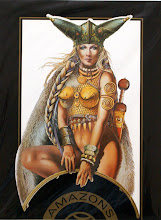Ted Benoit has, since the 1980s, been a prominent artist working in the ligne claire style made popular in the pages of the Franco-Belgian comics Tintin and Spirou.
Born Thierry Benoit in Niort, Deux-Sèvres, in rural France on 25 July 1947, he studied cinematography at the Institut des hauntes études cinématographiques in Paris and later worked in television. His first comics appeared in 1971 after he joined the editorial team of alternative magazine Actuel.
A fan of Hergé and Edgar P. Jacobs, whose works (principally 'Tintin' and 'Blake et Mortimer') filled the pages of Le journal de Tintin, Benoit shared his enthusiasm with other artists who were based around the Pigalle neighbourhood of Paris, leading one of its proponents, François Avril, to coin the term "École Pigalle". This "school" of artists--including Jacques de Loustal, Charles Berberian and Philippe Petit-Roulet--helped filled the pages of A suivre and L'Écho des Savanes and other popular French comics in the mid-1980s.
Benoit published a number of strips in the mid-1970s, 'Géranomimo' (1974) and Métal Hurlant from 1976. He also began contributing to L'Écho des Savanes after meeting cartoonist Nikita Mandryka in 1975 and it was here that his 'Ray Banana' strips began appearing in 1978.
His first album, Hôpital (Hospital), was published by Les Humanoïdes Associés in 1979, which won the award for best script at the Festival at Angoulême. His follow-up, Vers la Ligne Claire (Towards the Clear Line, 1980), gathering stories from Libération and Métal Hurlant, showed how his style of drawing was evolving from underground to clear line and had an introduction by Joost Swarte, who had coined the term "linge claire".
More one-off stories featuring Ray Banana began appearing in A suivre in 1980, followed by the serials 'Berceuse électrique' (Electric Lullaby, 1981) and 'Cité Lumière' (City Light, 1984), both subsequently published in album form by Casterman. Further stories from A suivre were collected as Histoires vraies (True Stories, 1982), written by Yves Cheraqui.
In 1987, Benoit created 'Bingo Bingo et son Combo Congolais' for Métal Hurlant and Métal Aventures as well as writing (for artist Pierre Nedjar), L'homme de nulle part (Nowhere Man, 1989), the memoirs of Thelma Ritter, Ray Banana's wife. A second volume of memoirs featuring Ritter was co-written by Madeleine DeMille and was to be drawn by François Avril but remains in limbo. (Ray Banana also appeared as a character in Philippe Paringaux's novel L'Homme qui ne Transpirait Pas in 1994.)
In 1993, Benoit was one of the artists responsible for reviving the continuing adventures of Blake and Mortimer, drawing two albums (#13 L'affaire Francis Blake, 1996, and #15 L'étrange rendez-vous, 2001) written by Jean Van Hamme.
Benoit's adaptation of Raymond Chandler's Playback, drawn by François Ayroles, appeared from Denoël in 2004.
He has also illustrated a number of books, prints and portfolios and has also been involved with l'association Le Crayon, whose members published The Naked Crayon in 2010. He has also been involved in advertising, notably for Jameson whisky and Bic.
Artwork/prints by Ted Benoir can be found for sale here.
Subscribe to:
Post Comments (Atom)




















No comments:
Post a Comment